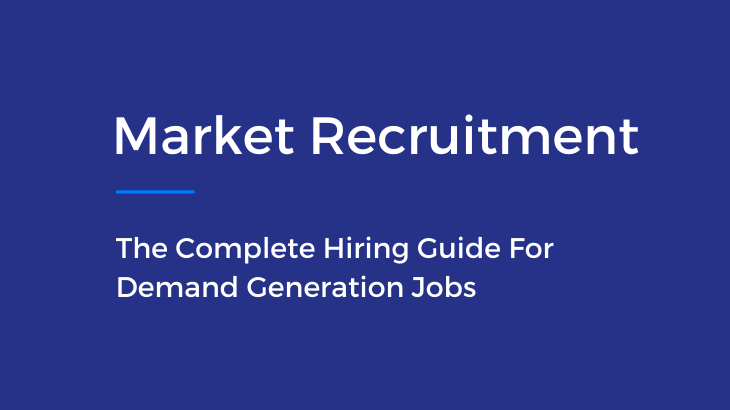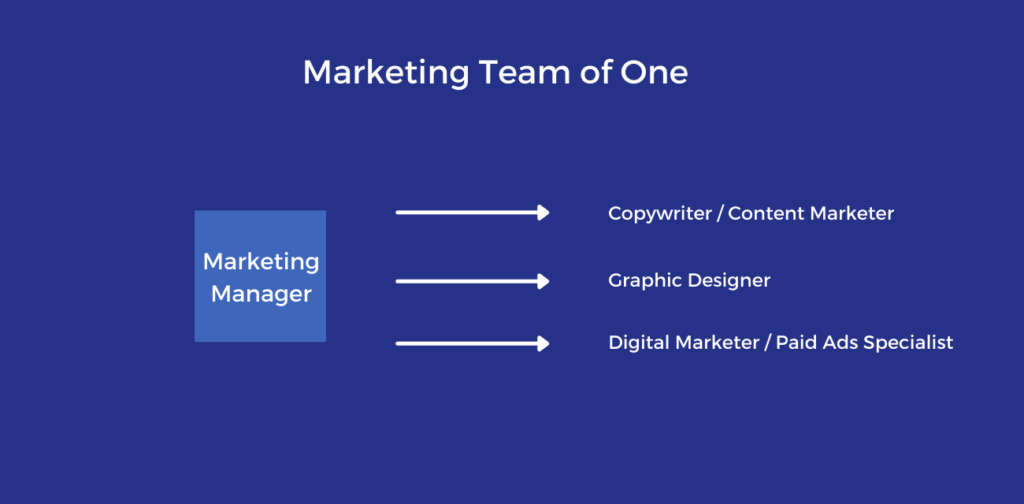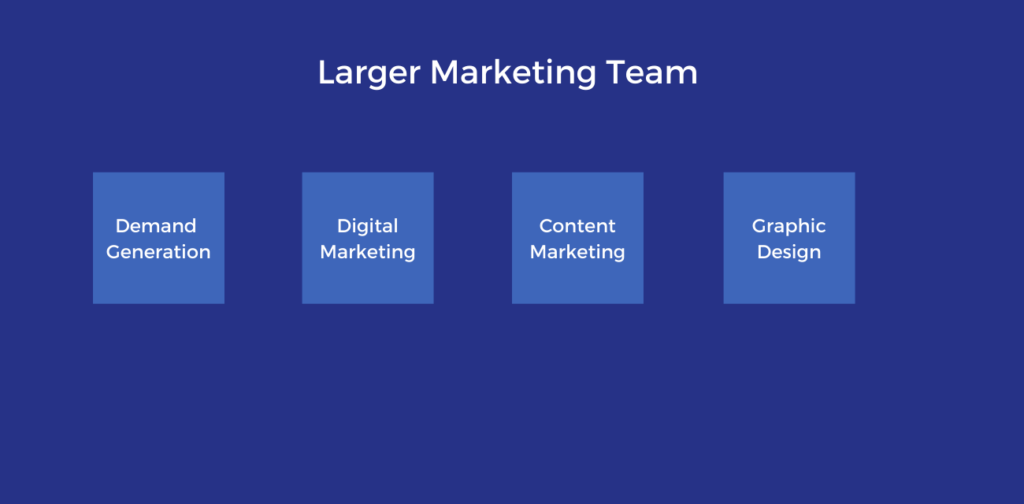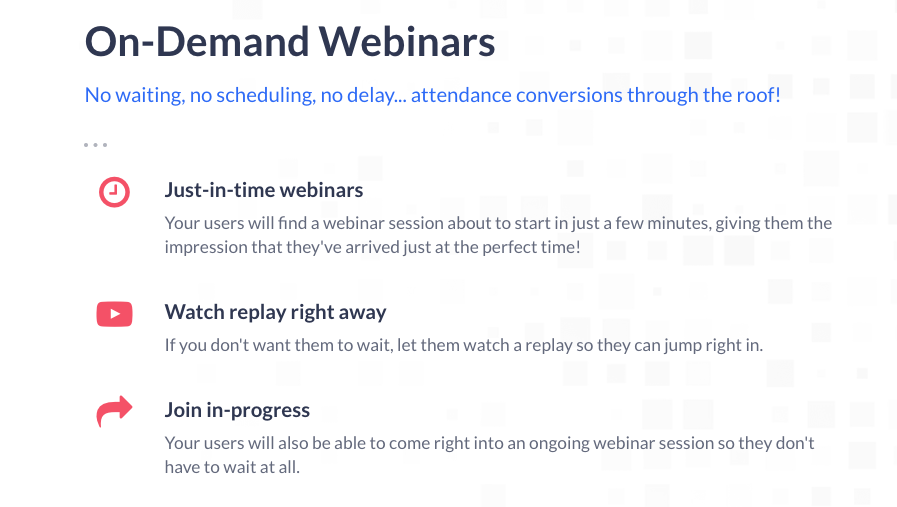
Demand generation is critical to the success of your B2B technology business. But of course you already know that, right?
Let’s be honest, most B2B tech businesses know they need to create demand. But that doesn’t mean it’s easy; deciding on the wrong tactics can waste your marketing budget, and even if you decide on the right tactics, hiring the wrong person puts your whole strategy in jeopardy.
The best way to improve demand generation is to create a clear strategy. And in this guide, we’ll help you understand how to create demand, how to fit demand generation into your marketing team, and how to hire someone who can transform your demand generation results.
Demand generation is an umbrella term that covers every aspect of acquiring a customer, from making them aware of your product or solution in the first place, to upselling them once they’ve become a customer.
Previously, demand generation was more focussed on creating leads for sales teams, but modern demand generation covers so much more.
If you’re a CEO or Startup Founder, you may think that because you’ve built an amazing product that solves your prospects problems, that demand will magically appear. Sadly, that’s not the case.
Even the most successful technology companies all have sophisticated demand generation focussed marketers with their company.
Often companies and hiring managers use the terms ‘demand generation’ and ‘lead generation’ interchangeably. But there is a difference.
Demand Generation is responsible for building awareness of your product or solution with your target audience. Tactics to do this may include blogging, podcasts, video marketing, thought leadership and social media.
Lead Generation is then responsible for turning that demand into leads. And typically leads that your sales team can follow up on. Because of that, lead generation tactics focus on getting your prospects’ information. And to do that a prospect could download e-books, sign up to a webinar, book a demo or subscribe to a newsletter.
Yet for most businesses, using a blend of both demand generation and lead generation drives the best results.
Because we know that creating demand is critical to your B2B Tech business’ success, it goes without saying that hiring a marketer that’s focussed on demand generation is a smart move.
But why?
Well, there are a couple of scenarios in particular where it makes sense to do this.
How do you generate leads if your target audience isn’t aware of their problem, or that there’s a solution to their problem?
Generally, if people aren’t searching for solutions like yours online, then you’ll more than likely have to focus on demand generation to make them aware of your solution first.
As an example, if your business sells CRM solutions, then because people are generally aware what a CRM does and the problem it solves, you could focus more on lead generation to drive more sales. Your marketing can focus more on your product, how it differentiates to your competitors and drive them to activate a free trial to get them using it.
On the flip side, if your business creates its own category like Drift did, then it needs to focus more on writing articles and creating content focussed on educating your target audience about the pains they have, and ultimately how your solutions help them overcome that.
Beyond getting your family, friends, previous colleagues and Fred (your dog) signing up as your first customers, it’s crucial for any Startup that can’t rely on its brand to generate demand.
Unlike Airbnb who recently cut their performance marketing due to the pandemic and still saw 95% of their traffic remain, Startups don’t have that luxury.
So in this scenario, hiring a marketer that’s focussed on demand generation should be one of the first hires you make into your marketing team.
Someone who can target the right people, build awareness of your solution and drive them down the funnel.
Additional Reading – Building a Demand Generation Team – 3 Examples
Demand generation can fit into your marketing team in a number of ways. And it generally depends on what stage of growth your business is in or the growth trajectory you’re expecting.
As you know, a VC backed unicorn will approach this differently to a bootstrapped Startup.
Generally speaking, and especially so for most early stage businesses, they’ll hire a generalist marketer with the title of Marketing Manager as their first marketer.
And get them to focus on demand generation as part of their role.
Typically in this setup, the marketer will work with external freelancers to help with any aspects they aren’t comfortable with. Those freelancers may include a copywriter / content marketer, a graphic designer and perhaps a paid ads specialist.

That way the marketer can use the content to create integrated demand generation campaigns and then be responsible for managing the lead flow through a marketing automation platform with the sales team.
Or, for Scaleups, well funded Startups or established brands, there may well be a demand generation specialist or even a team of people that solely focus on demand generation.
And then that team works collaboratively with other internal teams across content, digital, design etc.

Either way, it’s important to have a clearly defined role and a technology stack that supports your demand generation activities.
About to start hiring? Check out our Demand Generation Marketing Job Descriptions to get you started
Now that we’ve agreed on what demand generation is and how it fits into your marketing team, lets now focus on how you can create a demand generation strategy that’s going to help your business achieve its goals.
Before you launch into anything, it’s important to sit down with your sales team and agree with them what a ‘lead’ is.
That last thing you want is to create a ton of MQL’s only to find the sales team won’t follow up with them.
It may be a smart move to target your demand generation efforts on generating SQLs rather than creating MQLs from people who have no intent to buy.
This step is important because if demand generation is going to succeed then marketing and sales need to be aligned.
Alongside this, it’s important to define some other objectives and goals which cover traffic, conversions and sales. Those could include;
Before launching into a load of demand generation campaigns, it makes sense to check that your persona’s are clearly defined.
And there’s no better way to do that than getting into the CRM and checking out your existing customers. You can start to segment them on;
As a step further, and one which we’d highly recommend, pick up the phone to them and find out more about why they’re a customer.
Ask them what their pain points are and what your product or solution helps them with specifically.
This research can help inform the marketing channels you use, your messaging and what sort of content to produce to help attract more customers like them.
If you’re a Startup without customers, you may need to reach out to people directly. A great play is to open up your beta for free and then speak to those customers who join.
Now, you can start to decide which marketing channels are going to work for your business. We’ve outlined some of the most common options;
Top of the funnel content focuses on building awareness with your target audience and helps educate them on their pain points and solutions available to them.
The mistake some B2B marketers make is to focus too much on their own product as the solution. Most people hate being pitched to, right?
So instead, create blogs, infographics, videos and podcasts that educate and add value to your prospects.
Once they become aware of your business, you can then target them with middle of the funnel and bottom of the funnel content to convert that traffic into leads.
Focusing on content and SEO is a longer play. But what if you don’t have time?
If you can’t wait, then paid ads are a great way to target your audience. Why wait for them to find you when you can go and target them today.
Again, it’s important to target your audience with content that’s engaging and doesn’t go in with the hard sell.
First though, go back to your persona’s and see where you audience hangs out. For most B2B businesses, LinkedIn is going to be a good starting point. Although, it’s important to understand if the cost of leads through LinkedIn is viable.
Once you’ve identified the right channel you can then start to flesh out how your campaign will work and how you’ll measure its success.
Additional Reading – How to Use LinkedIn Ads to Drive More Leads
Can you believe email marketing is 24 years old?
And when you think of it, there are few marketing tactics that have stood the test of time like email marketing has.
But when it comes to email marketing, there a few tactics you can use to drive demand;
Unlike paying for paid ads, in comparison cold email outreach can be a more cost effective approach to generating demand.
And whilst it takes some time to craft a great email sequence that is effective, once you’ve nailed the sequence, you can run these campaigns on autopilot.
Our favourite tools to do this include;
Marketing Automation continues to be one of the fastest growing segments. And for good reason.
Essentially, marketing automation rids you of all the manual tasks associated with running an email marketing list, with the ability to personalise your marketing based on your users behaviour.
Here’s a case study of how a company increased its leads by 5X using Active Campaign – it gives you some great ideas about how to implement it in your business.
This strategy has been a staple B2B demand generation play for years.
Yet it still works. But, only if what you’re giving away is truly valuable to your audience.
Proposify, as an example, gives away free proposal templates despite earning revenue from users signing up to its proposal software tool.
Create a guide, e-book, white-paper and gate the content so that a prospect gives you their email in exchange for the asset.
You can then nurture the prospect with more valuable content and drive them further down the funnel.
According to a study from BightTALK, a content and demand marketing platform, 91% of B2B professionals say webinars are their top learning format.
So creating a webinar strategy to complement your demand generation efforts is a smart move.
And you have two choices when it comes to webinars.
For Startups, or those companies that are time poor, then you can create an evergreen automated webinar strategy using a tool like Everwebinar.
Because you’re not delivering the webinar live, you can offer multiple time slots to participants or even a ‘watch now’ option.

This can significantly reduce no shows, which often happen if people sign up a week before a webinar takes place.
The other option is to deliver the webinar live. One of our favourite platforms for doing this is Demio.
The best webinars deliver loads of value to the attendees, particularly around a pain point or something they’re keen to learn about.
And once they’ve attended the webinar, you can follow up with them with more helpful content, or even offer them a demo to your solution.
Another great demand generation tactic is to implement a product-led growth strategy.
Essentially, being product-led gets your users to experience your product quickly, reducing their friction, helping them get to their ‘aha’ moment, and without asking them to pay.
You can offer either a ‘free trial’ or ‘freemium’ model, and then allow anyone who signs up to pay for additional features.
A great example of a company using a Product-led Growth Strategy is Calendly.
And here’s a great Guide that shows how they use this Strategy to drive demand and grow.
Additional Reading – Demand Generation Strategy – 6 Marketing Ideas for Your SaaS Business
Let’s say you’re a specialist Demand Generation Marketing Manager.
On a day to day basis, here are some of the tasks you might get involved in;
We’d always suggest you measure the performance of your marketers both quantitatively and qualitatively.
Or in simpler english (I find that easier), with some number focussed targets and some objective based targets.
Using a typical SMART objective model, you could target your Demand Generation Marketing Manager on the following objective metrics;
Now clearly, these are more project based and less focussed on numbers. Which is why you’ll probably want to pair targets like this with some number targets too.
Here, you’ll probably want to have a think about what your overall business and marketing goals are, and then create demand generation metrics to hit that are in line with those.
Some examples could be;
And you could always go further, depending on your growth, and target based on pipeline growth, average deal size and average sales cycle.
Just remember, that it’s all good and well targeting someone on MQLs (because that’s what we’ve been told for years) but that doesn’t mean there’s intent.
Getting a load of sign ups to a webinar doesn’t mean anyone’s going to purchase your products.
The most effective marketing teams we’ve worked with put more emphasis on SQL’s and sales revenue.
Additional Reading – The 7 Demand Generation Metrics You Should Be Tracking
Check Out Another 10 Interview Questions for Demand Generation Marketers
Salaries for demand generation marketers will vary across sectors and sizes of company’s.
It’s more common in high growth Startups and Scaleups to reduce the base pay but offset that with equity.
The following salaries are for jobs based in London.
£130,000 – £140,000
£110,000 – £125,000
£95,000 – £105,000
£80,000 – £95,000
£60,000 – £75,000
£35,000 – £45,000
It’s time to take what you’ve learned and start building a demand generation machine.
Every B2B Tech business needs a strategy to help them drive demand in a way that builds your fanbase and differentiates you from your competition.
Your business will win by marketing smart – hiring really switched on people with energy, ideas and enthusiasm and pairing that with a demand generation strategy that drives pipeline growth on autopilot.
Subscribe to our fortnightly newsletter to hear about our latest podcasts, blogs, career advice & jobs.